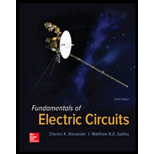
Concept explainers
Find the time-varying function
Answer to Problem 55P
The time-varying function
Explanation of Solution
Given data:
The differential equation is,
The initial conditions are zero. That is,
Formula used:
Write the general expression for the Laplace transform.
Write the general expression for the inverse Laplace transform.
Write the general expressions to find the Laplace transform function.
Here,
Write the general expressions to find the inverse Laplace transform function.
Calculation:
Apply Laplace transform function given in equation (2), (4), (5), (6) and (7) to equation (1).
Substitute 0 for
Rearrange the equation (13) to find
Reduce the equation as follows,
Expand
Here,
A, B, C, D and E are the constants.
Now, to find the constants by using residue and algebraic method.
Constant A:
Substitute equation (14) in equation (16) to find the constant A.
Constant B:
Substitute equation (14) in equation (17) to find the constant B.
Constant C:
Substitute equation (14) in equation (18) to find the constant C.
Consider the partial fraction,
Reduce the equation as follows,
Equate the coefficients of
Substitute
Equate the coefficients of
Substitute
Substitute
Reduce the equation as follows,
Apply inverse Laplace transform given in equation (3) to equation (22). Therefore,
Apply inverse Laplace transform function given in equation (8), (9), (10) and (11) to equation (23).
Conclusion:
Thus, the time-varying function
Want to see more full solutions like this?
Chapter 15 Solutions
Fundamentals of Electric Circuits
- 15 - When the unit step function is applied to the system input given the block diagram below, the output response takes the value c (0.2) = 0.11 for t = 0.2 s and c (infinity) = 0.333 for t = infinity. What is the steady-state error of the system? calculate.A) 0.33B) 0C) 0.25D) 0.5E) 0.67arrow_forward1) Find1 the inverse Laplace transform ofa) s+17 s2+4s-5 b) 3s-5 (s+1)(s2+2s+5) c) 16s+43 (s+2)(s+3)2arrow_forwardQ1. Solve the following difference eq . y(k)-0.7y(k-1)+0.12y(k-2)=(0.5)^ k 1. Analytically 2. Using Z transformarrow_forward
- Consider the differential equation for the instantaneous charge q(t) on the capacitor in an LRC-series circuit is given by L(d2q/dt2)+R(dq/dt)+(1/C)q=E(t) Use the Laplace transform to find q(t) whenL= 1 h,R= 20 Ω,C= 0.005 f,E(t) = 150 V,t >0,q(0) = 0, andi(0) = 0. What is the current i(t)arrow_forwardSolve for the differential equations of [ x cos^2 (y/x) - y] dx + xdy = 0 when x = 1 , y = pi/4arrow_forwardWhich is the imaginary part of the analytical complex function f(z)=u(x,y)+i v(x,y) given the real part above?arrow_forward
- 1: Consider the circuit shown in Figure below: 10 TQ v,(1) ‘ 5SH 01F Assuming that the value of v5(t) = 10u(t) V and at t = 0 a current of (—1 A) flows through the inductor and (+5 V) voltage across the capacitor. Using Laplace transform method to find i. The voltage across the capacitor for all time ¢t > 0. ii. The current flows through the inductor for all time ¢t > 0.arrow_forward1. Find the Laplace transform of (e^(2t))sinh(4t) – (e^(3t))cos(5t). A. (-s^3 + 11s^2 – 56s + 196) / (s^4 – 10s^3 + 78s^2 – 256s + 680)B. (-s^2 + 13s - 50) / (s^3 – 12s^2 + 20s + 96)C. (-s^3 + 11s^2 – 24s + 100) / (s^4 – 10s^3 + 46s^2 – 64s – 408)D. (-s^3 + 11s^2 – 56s - 4) / (s^4 – 10s^3 + 28s^2 – 56s – 320)arrow_forwardSketch the poles and zeros on the s-domain plot( complex plane) for the following function: H(s)= [(s+6)(s-2)]/[(s-3)(s+5)((s-3)^2 +9) For each pole and zero, examine its location in the s-plane and comment on its contribution to the systems behavior. Please answer in typing format please ASAParrow_forward
- Solve the following differential equations by using Laplace transform method. 2y'' + 4y' +10y =δ (t) Assume zero initial conditions.arrow_forwardHow many roots of the following polynomials are in left side, right side and jw axis of s-plane. P (s) = S4 + 2S3 + 10S² + 20S + 5 = 0arrow_forwardGiven a system with input x(t) and impulse response h(t) given by: x(t) = t ^ 3 u(t) and h(t) = t ^ 2 u(t) . Find the equation of output y(t).arrow_forward
 Introductory Circuit Analysis (13th Edition)Electrical EngineeringISBN:9780133923605Author:Robert L. BoylestadPublisher:PEARSON
Introductory Circuit Analysis (13th Edition)Electrical EngineeringISBN:9780133923605Author:Robert L. BoylestadPublisher:PEARSON Delmar's Standard Textbook Of ElectricityElectrical EngineeringISBN:9781337900348Author:Stephen L. HermanPublisher:Cengage Learning
Delmar's Standard Textbook Of ElectricityElectrical EngineeringISBN:9781337900348Author:Stephen L. HermanPublisher:Cengage Learning Programmable Logic ControllersElectrical EngineeringISBN:9780073373843Author:Frank D. PetruzellaPublisher:McGraw-Hill Education
Programmable Logic ControllersElectrical EngineeringISBN:9780073373843Author:Frank D. PetruzellaPublisher:McGraw-Hill Education Fundamentals of Electric CircuitsElectrical EngineeringISBN:9780078028229Author:Charles K Alexander, Matthew SadikuPublisher:McGraw-Hill Education
Fundamentals of Electric CircuitsElectrical EngineeringISBN:9780078028229Author:Charles K Alexander, Matthew SadikuPublisher:McGraw-Hill Education Electric Circuits. (11th Edition)Electrical EngineeringISBN:9780134746968Author:James W. Nilsson, Susan RiedelPublisher:PEARSON
Electric Circuits. (11th Edition)Electrical EngineeringISBN:9780134746968Author:James W. Nilsson, Susan RiedelPublisher:PEARSON Engineering ElectromagneticsElectrical EngineeringISBN:9780078028151Author:Hayt, William H. (william Hart), Jr, BUCK, John A.Publisher:Mcgraw-hill Education,
Engineering ElectromagneticsElectrical EngineeringISBN:9780078028151Author:Hayt, William H. (william Hart), Jr, BUCK, John A.Publisher:Mcgraw-hill Education,





